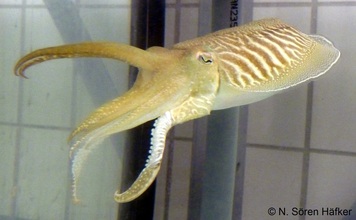
"Bei meiner Forschung arbeite ich mit dem Gemeinen Tintenfisch Sepia officinalis (oft einfach Sepia genannt). Diese Tiere gehören zur Klasse der Cephalopoden („Kopffüßer“), die auch Kraken und Kalmare einschließt.
Ausgewachsene Sepien erreichen eine Größe von ca. 20 cm (manchmal bis zu 50 cm). Der natürliche Lebensraum der Art sind die europäischen Schelfmeere. Man findet sie von der Ostsee bei Kiel über die Küsten Großbritanniens, Frankreichs und Spanien bis ins Mittelmeer. Die Tintenfische schwimmen meist nahe dem Meeresboden, wo sie nach Nahrung (kleine Krebse, Fische oder Weichtiere) suchen. Im Laufe ihrer Entwicklung ziehen sich die heranwachsenden Tiere in tiefere, küstenferne Gewässer zurück. Für die Paarung kehren sie an die Küsten zurück, wo sie ihre Eier an Seegräsern, großen Algen oder ähnlichen Strukturen befestigen und danach verenden. Der komplette Lebenszyklus dauert gewöhnlich nicht länger als 2 Jahre. Wie bei fast allen Cephalopoden ist er somit sehr kurz, geht jedoch mit einem sehr schnellen Wachstum einher.

Obwohl die Pflege von Sepien in Gefangenschaft also recht simpel ist, brauchen sie regelmäßige Fürsorge. Das bedeutet auch, dass an Wochenenden oder Feiertagen die Tiere stets Vorrang haben. Trotzdem möchte ich die Arbeit mit Tintenfischen keineswegs missen. Die Cephalopoden haben sich in Konkurrenz mit den Fischen entwickelt und gelten als die am höchsten entwickelten Wirbellosen. Kraken zeigen ausgeprägte Problemlösungsfähigkeiten und Kalmare können ihre Jagd durch blitzschnelle Farbwechsel ihrer Haut untereinander koordinieren. Die Grundlage für ihren hohen Stoffwechsel bilden ein fein abgestimmtes Blutsystem mit 3 Herzen, sowie ein kompliziertes Geflecht von zellulären Stoffwechselwegen. Da die Fischbestände durch den Menschen immer weiter schrumpfen, gewinnen Cephalopoden im Ökosystem Meer aber auch als Nahrungsmittel für den Menschen immer mehr an Bedeutung. Die Aufgabe der Forschung wird es sein, zu untersuchen, wie sich die Folgen des Klimawandels (steigende Temperaturen, Ozeanversauerung, Sauerstoffarmut) auf diese Tierklasse auswirken. Ich versuche dazu beizutragen, indem ich am Alfred-Wegener-Institut die Auswirkungen von niedrigen Sauerstoff- und hohen CO2-Konzentrationen auf die Stoffwechselwege des Sepien untersuche."
Marine Biology: Insight into a cuttlefish research project

"I am conducting research on the common cuttlefish Sepia officinalis. These animals belong to the class of the cephalopods, which also contains octopuses and squids.
Adult cuttlefish reach a size of about 20 cm (sometimes up to 50 cm). The natural habitats of this species are the European shelf seas. They can be found from the Baltic Sea near Kiel over the coasts of Great Britain, France and down to the Spanish coast. They are also found in many areas of the Mediterranean Sea. The cuttlefish spend most of the time close to the seafloor where they search for food (small crabs/shrimps, fish or molluscs). The growing animals retreat into deeper, more offshore waters In the course of their development. For reproduction, the adult cuttlefish return to the shallow coastal waters, where they mate and attach their eggs to seaweed, large algae or similar structures. Afterwards they die. The complete life cycle usually takes less than 2 years. Hence, it is (as for most cephalopods) very short, but it is characterized by very fast growth.
In contrast to most of their relatives, cuttlefish can be reared in captivity quite easily. Usually they lie calmly on the ground of their tank or they are hovering in the water. Although cuttlefish tend to live solitary, they can be kept in large groups without any problems. The animals reproduce in captivity and the eggs develop into healthy offspring. This is a good proof that the cuttlefish are not much affected by the life in the tank. To rear cuttlefish properly, it is necessary to keep an eye on the water quality. The fast growth of cephalopods is enabled by an extremely high metabolic rate, which however causes a rapid accumulation of waste products in the water. Thus, a regular supply with fresh seawater is absolutely essential (unfortunately, this disqualifies them as pets for private homes). Feces and leftovers of food have to be removed constantly, too. Usually they are fed with small shrimps. The cuttlefish catch their prey with two tentacles, which are hidden between their eight other arms (as you can see in the video).
Although the rearing of cuttlefish in captivity is quite easy, the animals need constant care. This also means that even on the weekend or during holidays the cuttlefish always have priority. Nevertheless, I would trade my work with them for nothing else. The cephalopods evolved in concurrence with the fish and are considered the most highly developed invertebrates. Octopuses show impressive abilities in solving problems and groups of squids coordinate the hunts by rapidly changing the color of skin. Their high metabolic rate is based on a finely tuned blood system with 3 hearts and on a sophisticated network of cellular metabolic pathways. Fish stocks are declining due to human activity and because of this the role of cephalopods in the marine ecosystem is growing. Also, the importance of cephalopods for fisheries is increasing. Future research will have to investigate the effects of climate change (rising temperatures, ocean acidification, hypoxia) on this animal class. With my work at the Alfred-Wegener-Institute (Bremerhaven, Germany) I try to contribute to this. Here, I investigate the consequences of low oxygen and high CO2 concentrations for the use of metabolic pathways in cuttlefish."
# See you soon! Bis bald! #

 RSS Feed
RSS Feed
